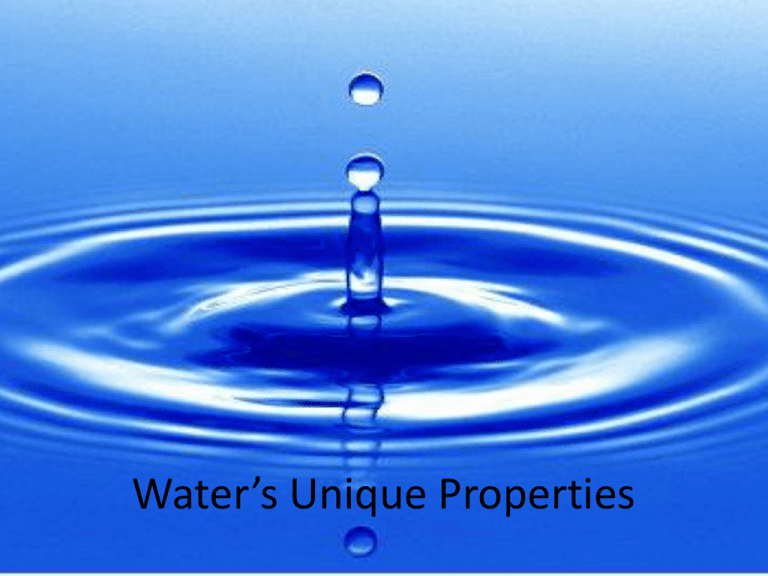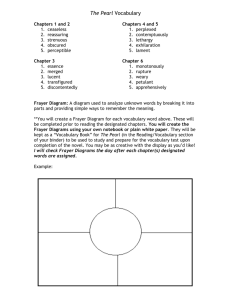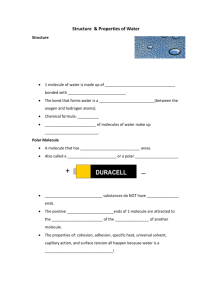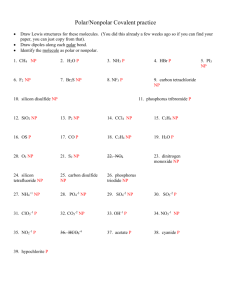Water*s Unique Properties
advertisement

Water’s Unique Properties What is the structure of water? • Water is a compound that contains two hydrogen atoms (+) and one oxygen atom (-). Due to the electrical charges water is known as a polar molecule. Chemical formula is H2O. • Looks like Mickey Mouse. Turn and Talk • You will partner with your neighbor. When I say go, partner A will discuss his/her understanding of the question while partner B listens. When I call time, partner B will share his/her understanding of the question and partner A will listen. – Topic: • Why does ice float? • How does ice floating in water relate to the properties of water? • What property of water is being discussed? How would our world be different without this property? What are the unique properties of water? • • • • • • • • Universal Solvent Capillary Action Adhesion Buoyancy Surface Tension Polarity Cohesion Density How is water a universal solvent? Answer: Water has the ability to dissolve most substances. Definition: - Universal Solvent: Water’s unique property to dissolve most substances. Teacher Guided Lab: “Water, the Universal Solvent” Real-World Examples: - Salt and water - Kool-aid - Instant pancake mix - Alka-seltzer Question (copy): How would our lives be different if water could not dissolve most substances? Frayer Model: Think-Pair-Share Is water polar or nonpolar? Answer: Water is a polar molecule. It contains a positive and negative charge. Definition: - Water’s property to have an even distribution of charge across the molecule. Background Info: - Polar molecule mix with polar molecule. (saltwater) - Polar and nonpolar do not mix. ( oil and water) - Nonpolar mix with nonpolar. (milk and chocolate syrup) Teacher Guided Lab: “Polar Pals” Quesion (Copy): How would our food look different if water was not a polar molecule? Frayer Model: Think-Pair-Shar Why do belly flops hurt? Answer: When entering a swimming pool your body is breaking the water’s surface tension. Definition: - The force that acts on the particles in water that allow it to become tight. Background Info: - The force that allows water to become tight is cohesion. - Cohesion: The attractive force between water molecules. Teacher Guided Lab: Sinkin’ Lincoln Question: How would the landscape of Earth be different if water molecules did not have cohesion and vaporized at room temperature? Frayer Models: (Surface Tension, Cohesion) Think-Pair-Share How do cruise ships float if they are so big? Answer: Cruise ships are able to float because of the upward force of buoyancy and the boats shape. Definition: - Buoyancy: The ability of a water to exert an upward force on an object that is immersed. Background Info.: - Density of water is 1.0 g/ml Salt and depth increase buoyant force. Real-World Examples: - Salt Lake Utah - Ice floating in water Teacher Guided Lab: “Passengers in a Boat” Question: Why can anyone float in the Great Salt Lake in Utah? Frayer Model: Think-Pair- Share Bowling ball. Sink or float? Why? Answer: A bowling ball would sink in water because it is more dense than the water. Definition: Density: The measure of mass of a substance in a given volume. Background Info.: - Density of water= 1.0 g/ml Teacher Guided Lab: “A Density Column” Frayer Model: Think-Pair-Share How do plant roots get their water from the soil? Answer: Plants roots rely on water’s property of capillary action. Definition: Capillary Action: The process that moves water through a narrow porous space. Real-World Ex. - Water and celery stick (picture) - Roots and soil water - Paper towel and spills Teacher Guided Lab: - Capillary Action Frayer Model: Think-Pair -Share Why does a suction cup stick better when you put water on it? Answer: Suction cups use water’s property of adhesion to stick to surfaces better. Definition: Adhesion: The tendency of water to stick to other substances. Real-World Examples: - Suction cup on a window - Rain on a rain jacket Teacher Guided Lab: Go with the Flow Frayer Model: Adhesion





